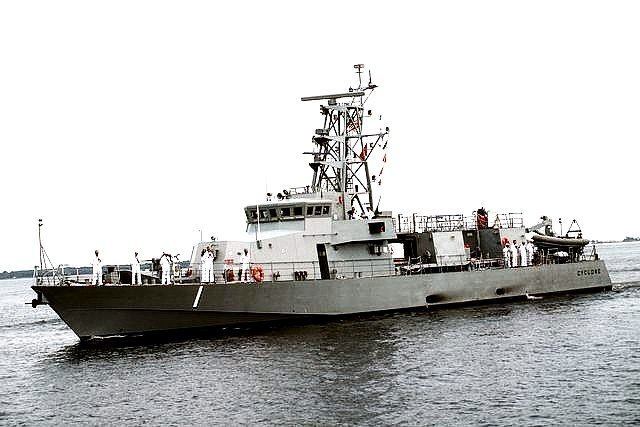Ordered 1 August 1990 Laid down 22 June 1991 Launched 1 February 1992 | Namesake Cyclone Cost $25.69 million Construction started 22 June 1991 | |
 | ||
Builder Bollinger Shipyards, Lockport, Louisiana | ||
USS Cyclone (PC-1) was the first of the Navy's Cyclone class coastal patrol ships. As the lead ship of her class, Cyclone served as the test bed for this series of 14 vessels. She was laid down at Bollinger Shipyards, in Lockport, Louisiana, on 22 June 1990, launched on 1 February 1992, and commissioned on 7 August 1993.
Contents
Ship's History
The primary mission of Cyclone was to serve as a platform for conducting maritime special operations, including interdiction, escort, noncombatant evacuation, reconnaissance, operational deception, intelligence collection, and tactical swimmer operations. Her small size, stealthy construction and high speed were tailored to performing long-range Special Operations Forces (SOF) insertion and extraction as well as other SOF support duties as needed.
The ship's operational capabilities were designed to meet the unique requirements of its Special Warfare missions. Operationally, Cyclone was capable of accelerating from stop to 35 knots (65 km/h) in under three minutes, then move from full ahead to 15 knots (28 km/h) astern in 60 seconds. In high-speed, hard-over turns, the ship barely heeled as the automatic stabilizers engaged.
Originally armed with two Mk38 25 mm chain guns fore and aft, several pintle mounts for attaching .50 caliber machine guns or Mk 19 grenade launchers, and a position for launching Stinger shoulder-fired SAMs, the Cyclone, along with others of her class, were upgraded early on by replacing the after Mk38 mount with the new Mk96 platform. The Mk96 combines both a 25 mm chain gun and a 40 mm grenade launcher on a single stabilized platform. The Mk96 features an electro-optical fire control system with 27x zoom, infrared and low-light modes, a laser rangefinder, and an array of environmental sensors, which feed data into the ballistics computer to produce an accurate firing solution even while maneuvering at high speed. The computer can also interface with the Stinger SAMs carried on board. The Navy was positive about the performance of the Mk96 and briefly considered up-gunning the 25 mm Bushmaster cannon to a 30 mm or even 35 mm cannon, but due to the high price this never came to pass.
Decommissioning and transfer
Cyclone had barely gone into service in the mid-1990s when the Special Operations Command rejected them as too big for commando missions, and the regular surface Navy dismissed them as too small for any of its missions. The Navy began looking for ways to phase out Cyclone and her sister ships, so on 28 February 2000, Cyclone was decommissioned and stricken from the Navy list.
She was then transferred to the United States Coast Guard the next day, being re-commissioned as the USCGC Cyclone (WPC 1). The Coast Guard lacked an effective vessel sized between its 110' patrol cutter and the 210' Medium Endurance Cutter, so there was considerable interest in Cyclone at first. However, her high operating costs were prohibitive and thus she sat largely inactive.
Transferred
USS Cyclone(PC-1) was eventually sold under the Foreign Military Sales Program to the Philippine Navy on 8 March 2004, as part of a US military aid package to the Philippines, in an effort to bolster interdiction and counterterrorism capabilities. She was rechristened BRP Mariano Alvarez (PS-38), in honor of a revolutionary general in the Philippine war of independence against Spain.
